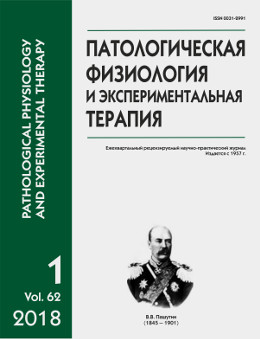Platelets apoptosis in rats after global brain ischemia
Abstract
The purpose. Stroke is one of the most common causes of disability and mortality in the world. A variety of experimental models for the investigation of stroke focused on monitoring of platelet apoptosis. However, study and detection of platelet apoptosis in ischemia stroke in rats are very scarce. Using flow cytometry, we investigated the platelet apoptosis in rats after global brain ischemia. Methods. Experiments were carried out on healthy adult Wistar male rats (300–350 g). For modeling of global brain ischemia we used two-vessel (2-VO) model occlusion combined with hypotension. Platelets were isolated by gel filtration on Sepharose 2B. To detection of phosphatidylserine (PS) externalization platelets were incubated with Annexin V-PE and analyzed on the FACSCalibur (BD Biosciences). We used JC-1, a mitochondrial membrane potential indicator, to detect of mitochondrial membrane potential (∆ψ) during platelets apoptosis. After incubations platelets were analyzed by flow cytometry immediately. Results. Our results indicate that PS externalization on platelets after global brain ischemia in rats was significantly higher (53.45 ± 4.21%) as compared to control group of rats (5.27 ± 2.40%). This finding was confirmed by the expressed depolarization of the mitochondrial membrane potential (ΔΨm). Our results demonstrated that in platelets of rats after experimental brain ischemia, almost 40% (35.24 ± 5.21%) of platelets were depolarized as compared to control group of rats. Conclusion. Our results provide an insight into mechanisms that are involved in the platelet apoptosis during ischemic stroke. Finally, this study lays the foundation for future of new therapeutic strategies.
Downloads
References
2. Velkov V. Free fatty acids - a risk factor for insulin resistance and ischemia: Prospects for risk assessment and diagnosis. Poliklinika. 2008; 4: 50-1. (in Russian)
3. Lopaschuk G.D., Ussher J.R., Folmes C.D., Jaswal J.S., Stanley W.C. Myocardial fatty acid metabolism in health and disease. Physiol Rev. 2010; 90(1): 207-58.
4. Brindley D.N., Kok B.P.C., Kienesberger P.C., Lehner R., Dyck J.R.B. Shedding light on the enigma of myocardial lipotoxicity: the involvement of known and putative regulators of fatty acid storage and mobilization. Am J Physiol. 2010; 298: E897-E908.
5. Chowdhury R., Warnakula S., Kunutsor S., Crowe F., Ward H.A., Johnson L. et al. Association of dietary, circulating, and supplement fatty acids with coronary risk: a systematic review and meta-analysis. Ann Intern Med. 2014; 160(6): 398-406.
6. Mozaffarian D., Lemaitre R.H., King I.B., Song X., Huang H., Sacks F.M. et al. Plasma Phospholipid Long-Chain Omega-3 Fatty Acids and Total and Cause-Specific Mortality in Older Adults: the Cardiovascular Health Study. Ann Intern Med. 2013; 158: 515-25.
7. Van Bilsen M., Planavila A. Fatty acids and cardiac disease: fuel carrying a messagе. Acta Physiol. 2014; 211(3): 476–90.
8. Rebrova T.Yu., Kondratieva D.S., Afanasiev S.A., Barzah E.I. Activity of lipid peroxidation and the functional state of the myocardium during cardiac remodeling in rats after experimental myocardial infarction. Kardiologiya. 2007; (6): 41-5. (in Russian)
9. Afanasiev S.A., Rebrova T.Yu., Kondratieva D.S. Features phospholipid composition of erythrocyte membranes in a myocardial infarction. Biomeditsinskaya Khimiya. 2007; (53): 541-46. (in Russian)
10. Afanasiev S.A., Kondratieva D.S. Popov S.V. Developing a model of comorbidity of heart failure and diabetes mellitus type 1 in the experiment. Bulleten experimentalnoy Biologii i Meditsyny. 2012; (153): 523-26. (in Russian)
11. Egorova M.V., Afanasiev S.A., Popov S.V. A simple method for the isolation of cardiomyocytes from adult rat heart. Bulleten experimentalnoy Biologii i Meditsyny. 2005; 140: 357-60. (in Russian)
12. Egorova M.V, Afanasiev S.A., Popov S.V. Role of phospholipase A2 in the activation respiration of isolated cardiomyocytes under postinfarction cardiosclerosis. Bulleten experimentalnoy Biologii i Meditsyny. 2008; 146: 631-33. (in Russian)
13. Egorova M.V, Afanasiev S.A. The regulatory role of free fatty acids in the maintenance of membrane homeostasis heart mitochondria in experimental myocardial ischemia. Bulleten sibirskoy meditsyne. 2012; (3): 31-8. (in Russian)
14. Aleksandrov A.A. Diabetic heart: Scramble for mitochondria. Consilium medicum. 2003; (5): 509-13. (in Russian)
15. Ashrafian H., Redwood C., Blair E., Watkins H. Hypertrophic cardiomyopathy: a paradigm for myocardial energy depletion. Trends Genet. 2003; (19): 263–8.






